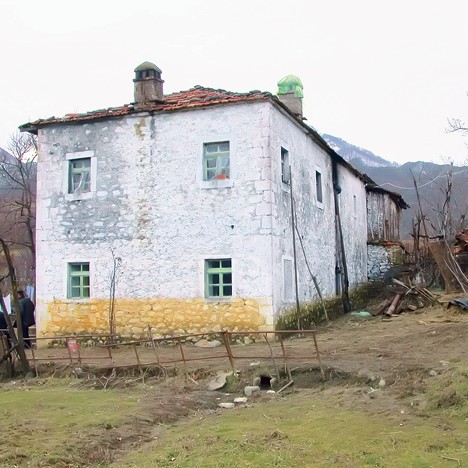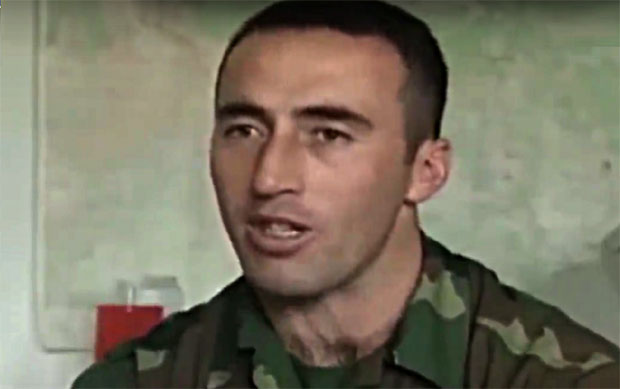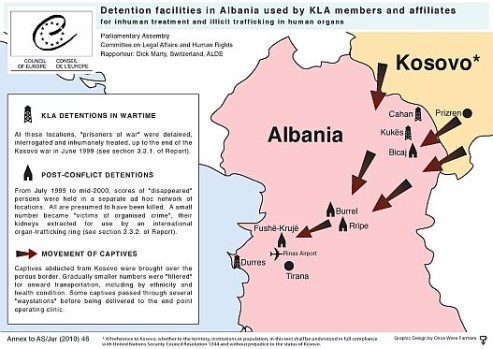Period:
21st century
Region:
Albania
The Albanian camp "Yellow House" in Burrel 1999
The Yellow House is the name for a special Albanian camp in the place called Ribe, near the town of Burrel in central parts of the Republic of Albania that existed in the late 1990s.
This death factory is known for human organ trafficking; that is, there was an improvised “clinic” in a house painted yellow, where kidnapped people from Kosovo and Metohija, mostly Serbs and non-Albanians, were brought, but also Albanians loyal to the institutions of the Republic of Serbia.
All the victims were killed and their organs (heart, liver, lungs, spleen, etc) were sold through Italy, first on the black (illegal) markets of the European and American continents, and later in the Middle East.
At least 50 people were involved in these monstrous crimes, mostly close associates of Hashim Thaçi, one of the founders of the so-called OVK (KLA - Kosovo Liberation Army), which was confirmed in Dick Marty’s report in December 2010.
Although Yugoslav state institutions, as well as numerous representatives of international bodies asked and warned the authorities of the Republic of Albania to initiate an investigation into the Yellow House camp, it has never been done.
The story was mentioned in the courthouse of the International Criminal Tribunal for the former Yugoslavia in the Hague, but it never had a court epilogue, because the Hague Tribunal has never indicted those responsible. EULEX filed indictments only in 2011, but judicial proceedings have not been completed to this day.
The Yellow House is considered one of the most monstrous camps after World War II, not only in Europe but in the whole world.
BACKGROUND
On On 15 January 1999, in the Kosovo village of Račak, Serbian police clashed with Albanian terrorists. The Western Media falsely reported that Serbian policemen killed Albanian civilians. They were instructed by William Walker, the head of the Kosovo Verification Mission.

Holbrooke in Belgrade with false offer
This case served as justification for the aggression and bombing of Serbia and Montenegro in 1999, which the Government of Serbia attempted to avoid in negotiations with Kosovo Albanians in Rambouillet. As this attempt failed, American general Wesley Clark ordered the bombing, which turned into genocidal action known as “Merciful Angel.”
SITUATION IN BURREL
Burrel is a small town located in the central part of the Republic of Albania, approximately 50 km northeast of the capital. Administratively, it belongs to the region of Dibrës.
At the end of the 20th century, there were around 14,000 inhabitants in Burrel, including a significant number of Serbs. One of the most famous Albanian Serbs was the writer and publicist Kaplan Burović.
After World War II, there was a large prison in Burrel where criminals and political opponents of Enver Hoxha were brought in. He was an Albanian communist dictator who carried out the reign of terror and violent Albanisation of Serbs who had a significant percentage in the northern and western parts of the People’s Republic of Albania.
At the beginning of the 1990s, that prison was turned into a museum.
ESTABLISHMENT OF THE CAMP
In spring 1999, when new violent armed conflicts between Albanian terrorists and Yugoslav security forces began, not only in the border zone, but on the entire territory of the Autonomous Province of Kosovo and Metohija, the notorious Drenička group of the so-called Kosovo Liberation Army under the command of Hashim Thaçi, kidnapped a large number of citizens, mostly Serbs and non-Albanians, but also the Albanians who were loyal to the Republic of Serbia.

The kidnapped Serbs who were taken from Kosovo and Metohija to the Republic of Albania
All of them were taken to one of 144 collection centers on the territory of Kosovo and Metohija, and there were at least 10 casemates on the territory of the Republic of Albania.
CAMP OPERATION
In a house owned by the Albanian family Katuchi, which is located at the end of the settlement Ribe, close to the town of Burrel (alb. Burrelj), people close to Hashim Thaçi improvised a clinic. This house was confiscated, i.e. seized. Although the homeowners knew what was going on in there, they had to be quiet for their safety.
Detainees were brought there and killed, their organs were immediately removed: heart, lungs, kidneys, spleen, liver, etc. They were put in special refrigerators. All of this happened in utmost secrecy, and very few people knew about it.
The organs were then distributed in two directions. The first one was by speedboats to Italy, from where they were further sold at high prices on the illegal markets in Western European countries to the rich who could pay for the “services”. But, there were also “buyers” from the USA and Canada. The other direction was to Muslim countries in the Middle East and Asia Minor.
Throughout 1999, this “business” was flourishing and the organizers made enormous profits acquired criminally and involving many European politicians of that time. According to witnesses, the income per victim was around 50,000 USD.
It is interesting that those involved in the criminal activities used a normal transportation system by using the airport “Majka Tereza” (Mother Teresa) near Tirana and flew commercial flights. The airport police and officials were bribed not to look at the contents of their “luggage”.
THE NAMES OF THE RESPONSIBLE
The names that the witnesses marked as involved in the work of the Yellow House are:
Hashim Thaçi, commander of the Drenička group, part of the so-called KLA… at the same time, he was the head of the whole chain of human organ trafficking.
Ramush Haradinaj, commander of the operational zone Dukagjin in the west of K&M. He organized the kidnapping and transfer to the Republic of Albania.
Daut Haradinaj, deputy to his brother Ramush, who maintained links with Turkey and Muslim countries in the Middle East.
Naim Maloku, member of the so-called KLA, organizer of transfer to the Republic of Albania.
Alija Lulaj from Elbasan, a criminal with good connections in the Middle East, found buyers and brought the money in.
Bernard Kouchner, head of the UNMIK Mission in occupied Kosovo and Metohija from July 1999 to January 2001. He received his share of money not to initiate any investigations.
Sabit Gecai, a close associate of Hashim Thaçi, in charge of transferring detainees from Kosmet to the Republic of Albania.
Yusuf Sonmez, a doctor from Turkey who performed all the operations in Burrel, earning the nickname “Turkish Frankenstein”.
CLOSING OF THE CAMP
It is not known when exactly the “Yellow House” was closed, but according to well-founded suspicions, it was functioning for more than a year, i.e. even after the cessation of hostilities in Kosovo and Metohija and the entry of international forces KFOR and UNMIK into the southern Serbian Province.
Initially, the criminals did not even remove the traces when the Yellow House stopped its criminal activities and it stood like that for years.

The place of the greatest fear and horror in the nineties, the yellow house repainted white.
TESTIMONIES
During the investigation about this most monstrous and most bizarre crime in the 20th century, several witnesses provided testimonies but sought protection.
The first protected witness, as a former member of the so-called KLA, said the following:
- I made four deliveries during 1999… on 20 July, 23 July, 2 August, 3 August. My superior was Petrit Agusholli, who told me for the first delivery that Reshad Zajmi had asked around about people who would ‘do a job’. Reshad’s group was considered very dangerous and operated in the Klina region.
I was told to drive a truck from Peć to Prizren. Not to ask anything, but to do everything as told because that is the only way I would live to a ripe old age. Agusholli was with me in the old dusty truck. We drove for about an hour and a half. After the ride, he ordered me to go towards Suva Reka. After a 15-minute drive, we passed the village Ljutoglav and we got off the road to a three-storey house. A group of 30 captured Serbs was waiting for us, guarded by a dozen armed members of the so-called KLA.
The captured Serbs were exhausted, covered in blood and dust; they probably walked for a long time. I didn’t see anything unusual there, because I thought we would take those Serbs to the exchange of prisoners. One of the prisoners said that his name was Dragan Jocimović from the village of Šilovo near Gnjilane and that he was 40 years old. The others were Serbs from Ratimlje, Opterušta, etc.
I drove them in the truck to Prizren where Agusholli got off, and two KLA members in civilian clothes got on, and we were accompanied by four members of the so-called KLA in a car behind us. When I asked where to drive, I was told to shut up.
On the way out of Prizren, we had a flat tire, so we had a short break, while captured Serbs, 15 of them, passed by us, accompanied by a Pinzgauer with the so-called KLA insignia. In the group, I recognized Vlastimir Stevanović from Prizren, about 30 years old, thin. When asked by a member of their company what would happen to them, I got the answer that they would ‘cut wood’ in Albania. There were also uniformed members in the group (army and police). They headed right to mountain Paštrik.
We continued to Kukës and across the border crossing, no one touched or asked us anything. There was a jam in the opposite direction because Albanian refugees were going back to Kosovo and Metohija. We arrived at about 4 p.m. A short break and we headed north. We delivered captured Serbs there and went back to Prizren.
The next tour was on 23 July at about 9 a.m. Ismet Tara, the gang leader in this area, was waiting for us then. We picked up the corpses of soldiers wrapped up in gray blankets. I smelled fresh blood and saw both men and women. They were Serbs from Orahovac, Gnjilane, and Suva Reka. They sprinkled them with some powders and liquids to suppress unpleasant odor. We went to Kukës again, where we arrived at about 12.30.
I turned south after Kukës, and at the end of the ride, I saw Enver Cokoli from SHIK (Albanian Intelligence Agency). He had worked in Priština until 1991 as a member of MUP (Serbian Ministry of Interior). Cokoli was a confidant of Bashkim Gazidede, a chief of SHIK in the 1990s.
Our escort from the “golf” unloaded the truck in masks and gloves. They threw the corpses into the already dug holes. The work lasted for more than an hour. The place was deserted, it reminded me of Afghanistan. We went back to Prizren and then went to Peć to return the truck.
My co-driver, whom I did not know, said he would call me again. On other occasions, in Albania, we were greeted by people from SHIK, among whom was Samari Amre. My brother also made some deliveries…”
Another protected witness said:
- ”Kosovo was divided into zones of interest, where each gang had its region and responsibility. They dealt with an organized crime even before the war: smuggling narcotics, weapons, cigarettes, money laundering… The most powerful were the Peć and the Prizren clans.
Daut Haradinaj and Naim Maloku were in charge of Peć, Đakovica, all the way to Junik. Maloku was equal to Ramush Haradinaj. In the second region, comprising Prizren, Suva Reka, Orahovac, and Uroševac, there was a gang controlled by Islam Kastrati and Gjelal from Prizren and Xhavit Elshani from Piran. In Uroševac, a certain Naser was in command who ‘supplied’ the Haradinaj brothers with captured Serbs from his region. These captured Serbs were literally sold.
Daut Haradinaj had his camps in the vicinity of Tropoja in Albania even in 1998. I was there in person and talked to the Haradinaj brothers: Daut and Ramush. These ‘deliveries’ took place even during the bombing, but the business expanded after June 1999.

Ramush Haradinaj, Albanian terrorist in the service of the European criminal activities
Ramush and Daut Haradinaj ordered their subordinates to restrain from revenge on Serbs and to kidnap them one by one and bring them to Prizren. They took them to northern Albania from there. They continued to revenge but to a lesser extent.
They used the Požega brothers for these jobs: Xhafer and Gjena, as well as Naser, whose surname I don’t remember. I know he was a tire vulcanizer before the war.
Xhavit Elshani from Piran enjoyed torturing Serbs, he was the commander of military police, the so-called KLA. He and his men used to wear black uniforms with KLA insignia. He came from a poor family, and he had committed crimes even before coming of age. He killed Serbian civilians, and even attacked police officers. He was cruel even to his associates if he suspected anything. Elshani had excellent cooperation with Daut Haradinaj.
Xhavit Elshani had three camps. The first in the village of Nasek near Prizren, and two more in northern Albania: Bicaj, and in the mountains south of Kukës. Mass graves were there.”
YEARS LATER
At the beginning of the 21st century, when the existence of this special camp was already known, journalists from the Republic of Serbia came to Burrel and found traces that said a lot. They found bandages, bottles with medicine alcohol, syringes, etc.
The owners of the house in which violent operations and human organ harvesting took place, painted the house white very quickly. But, they did not remove medical supplies and material, and the journalists took photos of them as evidence.
Moreover, when the Yugoslav Army and Police, as well as state institutions, withdrew from Kosovo and Metohija in June 1999, and the southern Serbian province was overtaken by the international forces UNMIK and KFOR, the criminal operations moved to “Medicus” clinic in Priština.
In early March 2010, when a journalist of Voice of America, at a press conference in occupied Priština, asked Bernard Kouchner, a former head of the UNMIK Mission after the arrival of international forces in Kosovo and Metohija, whether he was familiar with the kidnapping of Serbs and non-Albanians from 1999 to 2000, as well as with the Yellow House camp, he changed his facial expression and angrily insulted the journalist.
A large number of witnesses to these horrible crimes were eliminated, i.e. killed in the period 1999-2005.
INDICTMENTS AND TRIALS
In early February 2004, Albanian police, together with a UN investigation team, came to Ribe, where they broke into the Katuchi family yard. They entered the yellow house to look for evidence of the operations. They stayed there for two days. The Katuchi family had lame excuses about the evidence found, but the fear on their faces was noticeable.
In mid-December 2010, Dick Marty, a Swiss lawyer, and senator submitted a report on Kosovo and Metohija before the European Parliament for human rights after a two-year investigation. All the evidence pointed to Hashim Thaçi as the main organizer of human organ trafficking, but other names were also mentioned. In the next few days, the EULEX Prosecutor’s Office filed an indictment against seven people in this criminal chain of human organ trafficking.

Map showing the way the victims were brought from Kosmet (Kosmet- Serbian short name for Kosovo and Metohija)
A month after Marty’s report, Turkish police arrested Jusuf Sonmez in Istanbul, according to an international arrest warrant by Interpol. He was known for international illegal human organ trafficking.
PUBLICATIONS
The international prosecutor at the Hague tribunal, Carla Del Ponte, published a book entitled “The Hunt: Me and the War Criminals” in March 2008, a part of which is dedicated to human organ trafficking in Kosovo and Metohija.
In 2003, Veselin P. Dželetović wrote a novel “The Serbian Heart of Johann” where he described the character of Jovan from Velika Hoča, who was kidnapped and his heart ended up in the body of a rich German Johann Wagner. This book has been awarded several times and has had 14 editions so far.

The Serbian Heart of Johann
In addition to Dželetović, a boy Saša Milivojev also wrote an autobiographical work entitled “The Boy from the Yellow House” where he summarised the horrific story about kidnapping and monstrous operations mostly performed on living people whose bodies were later buried in secret graves.

The Boy from the Yellow house
Several documentaries about the Yellow House and illegal human organ trafficking have been filmed so far.
Tags:
Please, vote for this article:
Visited: 33154 point
Number of votes: 176
|